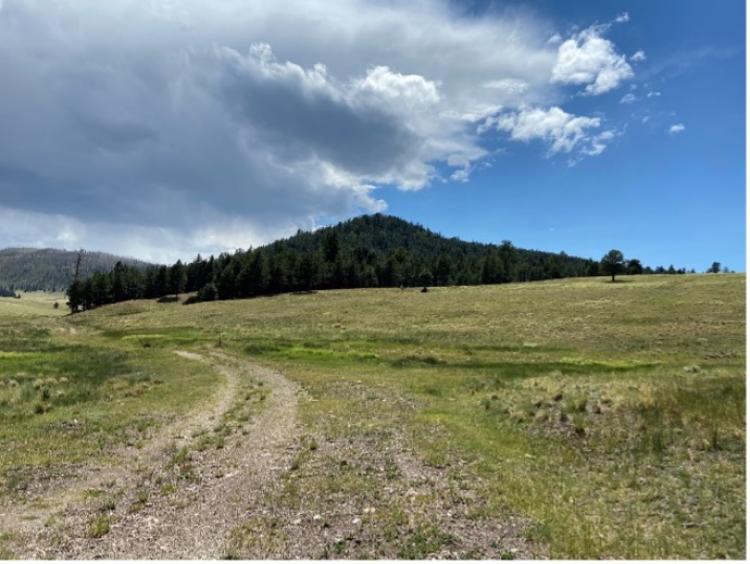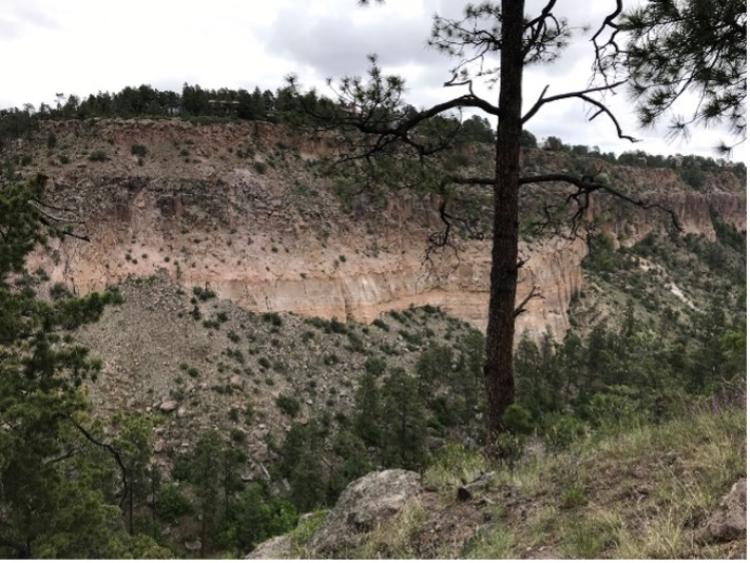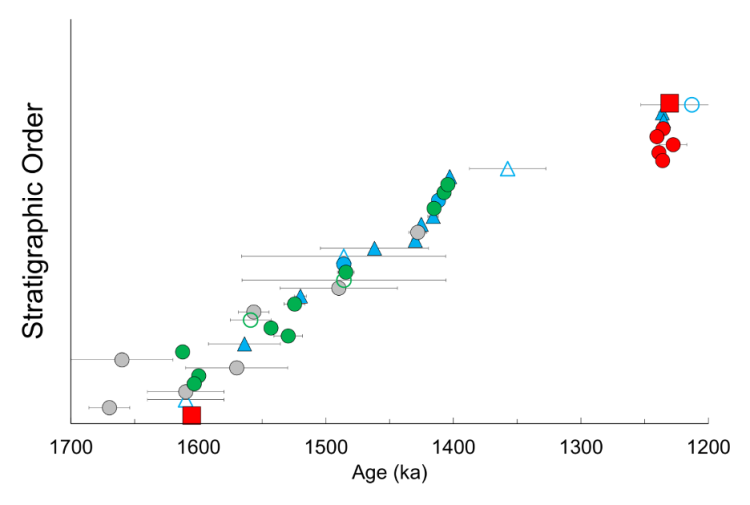Nick Meszaros - Project Profile
2021 AGeS awardee
Lab: New Mexico Geochronology Research Laboratory
What scientific question(s) does your research address and what motivates this work?
How did eruption tempo evolve in the Jemez Mountains Volcanic Field (JMVF) leading up to the last caldera-forming eruption? Despite no eruptions occurring in the last ~70 kyr, the JMVF presently retains a voluminous and partially molten magma reservoir beneath Valles Caldera (Steck et al., 1998). The current prolonged period of volcanic repose could be indicative of the system trending towards extinction. Alternatively, long durations that are absent of volcanism may be required to enlarge a silicic magmatic system to a magnitude that can produce supervolcanic eruptions. A key objective of my research is to contextualize the current state of the Jemez system by testing whether there is precedence for volcanic hiatuses on the order of 104-105 years prior to significant increases in volcanic output. Furthermore, rhyolites erupted during caldera events and immediate precursory activity in the JMVF are fayalite-bearing, as opposed to older inter-caldera and post-caldera rhyolites that lack fayalite. Determining the timing of this transition in the crystal cargo of erupted rhyolites, as well as its petrological significance, is a further objective of my research to reconstruct the timescales of changes that preceded caldera volcanism in the Jemez system. The results of my project have implications for volcanic hazards in the U.S. southwest and will advance understanding about the volcanic tempo of large silicic magmatic systems at various stages within caldera cycles.


Figure 1:Left: Cerro Trasquilar Dome, erupted between two caldera-forming eruptions, viewed from Valle Toledo in Valles Caldera. Right: The eruptive products (Tshirege Member of the Bandelier Tuff) of the most recent caldera-forming eruption in the JMVF overlying precursory eruptive products and volcaniclastic sediments of the Cerro Toledo Formation in Pueblo Canyon (Los Alamos, New Mexico).
What chronometric tool did you employ and why?
I used 40Ar/39Ar sanidine geochronology to determine the ages of eruptions between two caldera-forming eruptions, as well as the ages of the initial Plinian events of both episodes of caldera volcanism. The 40Ar/39Ar sanidine geochronometer is well suited for my project, in part, because sanidine is abundant in almost all rhyolites erupted in the JMVF and often appear unaltered by post-emplacement processes. While not entirely melt inclusion free, most sanidine grains do not contain an overabundance of inclusions that may sequester excess 40Ar. Argon in sanidine also re-equilibrates at lower temperatures than U and Pb does in zircon, thus reducing the probability (compared to zircon) of inherited grains recording erroneously old eruption ages. The ability to step-heat individual sanidine grains further improves the reliability of sanidine eruption ages, as crystal zones that have either lost Ar since emplacement or that sequestered excess 40Ar are ideally degassed before the entire crystal fuses. In the context of my project, high-precision ARGUS VI noble gas mass spectrometry typically yields ± several kyr 2σ uncertainties on combined weighted mean ages of 20-40 individual crystal ages. This temporal resolution is sufficient to reveal eruption hiatuses with durations that are as low as 5 kyr.

Figure 2: The ARGUS VI noble gas mass spectrometer at the New Mexico Geochronology Research Laboratory.
What were some of the key takeaways of your research?
- Eruption tempo was heightened (~1 kyr/eruption) for several kyr before and after large caldera-forming eruptions.
- Eruption tempo was comparatively lower (~ 8 kyr/eruption) during the remainder of the inter-caldera interval, culminating in a long-lived hiatus of 117 ±33 kyr.
- The eruption hiatus ended only 8.6 ±3.4 kyr prior to the second caldera-forming eruption. The resumption of volcanism coincided with the first appearance of fayalite in erupted rhyolites since the first caldera-forming eruption.

Figure 3: Eruption record between two caldera-forming eruptions in the Jemez Mountains Volcanic Field. Uncertainties plotted are 2σ. Red= fayalite-bearing rhyolite, blue= biotite-bearing rhyolite, green= hornblende/pyroxene-bearing rhyolite, grey= unknown mineralogy, circles= tephras, triangles= lava domes, squares= caldera-forming eruptions, filled= ages from my project, open= ages from Izett et al. (1981), Stix et al. (1988), Spell et al. (1996), Justet and Spell (2001), Kelley et al. (2015), or Jacobs et al. (2016). This study is ongoing and these results are subject to change prior to formal publication.
What new experiences, opportunities, and collaborations did you gain as an AGeS-Grad awardee?
A geochronology project was not originally planned for part of my dissertation research. My other projects are focused on understanding the petrologic relationship and implications of mineralogically distinct pre-caldera rhyolites at Valles Caldera. Incorporation of eruption ages into my research has provided an additional perspective that has greatly enhanced the petrologic story that I pieced together. Without the AGeS program, this would not have been possible. The lab experience that I gained while working on my AGeS project was also highly rewarding. I spent several days working with Dr. Matthew Zimmerer at the New Mexico Geochronology Research Laboratory. While there, I learned more about mass spectrometry and gained my initial introduction into processing and interpretating geochronological data. Dr. Zimmerer and I have continued working together on reanalyzing some challenging samples and preparing a manuscript for future publication. After completing my PhD, I aspire to learn more about geochronology and continue to work on geochronologic research problems related to volcanism and magmatism. I am very grateful for the wonderful experiences that the AGeS program has made possible for me.
What is one piece of advice you have for future AGeS-Grad award applicants or awardees?
If possible, add your lab collaborator to your Master’s or PhD committee. Doing so increases your collaboration beyond the lab visits and presents many more valuable educational opportunities.
References:
Izett, G.A., Obradovich, J.D., Naeser, C.W., and Cebula, G.T., 1981, Potassium-argon and fission-track zircon ages of Cerro Toledo Rhyolite tephra in the Jemez Mountains, New Mexico, in Shorter Contributions to Isotope Research in the Western United States, 1980: U.S. Geological Survey, Professional Paper 1199 A-E, p. 37-43.
Jacobs, E.P., WoldeGabriel, G., Kelley, S.A., Broxton, D., and Ridley, J., 2016, Volcanism and sedimentation along the western margin of the Rio Grande rift between caldera-forming eruptions of the Jemez Mountains volcanic field, north-central New Mexico, USA: Journal of Volcanology and Geothermal Research, v. 327, p. 416-435, doi: 10.1016/j.volgeores.2016.09.012.
Justet, L., and Spell, T.L., 2001, Effusive eruptions from a large silicic magma chamber: the Bearhead Rhyolite, Jemez volcanic field, NM: Journal of Volcanology and Geothermal Research, v. 107, p. 241-264, doi: 10.1016/S0377-0273(00)00296-1.
Kelley, S.A., McIntosh, W.C., Goff, F., Kempter, K.A., Wolff, J.A., Esser, R., Braschayko, S., Love, D., and Gardner, J.N., 2015, Spatial and temporal trends in pre-caldera Jemez Mountains volcanic and fault activity: Geosphere, v. 9, no. 3, p. 614-616, doi:10.1130/GES00897.1.
Steck, L.K., Thurber, C.H., Fehler, M.C., Lutter, W.J., Roberts, P.M., Baldridge, W.S., Stafford, D.G., and Sessions, R., 1998, Crust and upper mantle P wave velocity structure beneath Valles caldera, New Mexico: Results from Jemez teleseismic tomography experiment: Journal of Geophysical Research, v. 103, p. 24301-24320, doi:0.1029/98JB00750.
Stix, J., Goff, F., Gorton, M.P., Heiken, G., and Garcia, S.R., 1988, Restoration of compositional zonation in the Bandelier silicic magma chamber between two caldera-forming eruptions: Geochemistry and origin of the Cerro Toledo Rhyolite, Jemez Mountains, New Mexico: Journal of Geophysical Research: v. 93, no. B6, p. 6129-6147, doi:10.1029/JB093iB06p06129.
Spell, T.L., McDougall, I., and Doulgeris, A.P, 1996, Cerro Toledo Rhyolite, Jemez Volcanic Field, New Mexico: 40Ar/39Ar geochronology of eruptions between two caldera-forming events: GSA Bulletin, v. 108, no. 12, p. 1,549-1,566, doi:10.1130/0016-7606(1996)108%3C1549:CTRJVF%3E2.3.CO;2.

